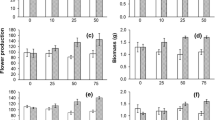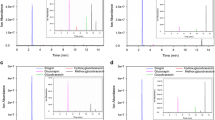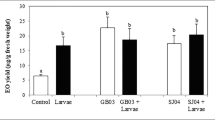Abstract
In the current study, potential involvement of anthocyanins in the defence of the Zn hyperaccumulator plant, Noccaea caerulescens, was investigated in two independent glasshouse experiments. Plants were grown in compost amended with a range of Zn concentrations. In the first experiment, foliar herbivory was simulated by clipping the shoots with scissors, whilst in second experiment, plants were subjected to natural herbivory by thrips (Frankliniella occidentalis). In both experiments, foliar Zn concentrations were approximately twice as high as that applied to the soil, indicating accumulation occurred. In the clipping experiment, foliar anthocyanin concentrations decreased by 22–45 % with increasing soil Zn amendments and clipping increased anthocyanin concentrations by 17–24 % relative to unclipped plants. In a thrips feeding experiment, Zn treatment had little effect on anthocyanin content although there was a trend towards increased anthocyanin production in plants grown at the lower concentrations of Zn. Anthocyanin concentration increased by 49–52 % in N. caerulescens leaves subjected to thrip attack compared to that of thrip-free shoots. Thus, anthocyanins increased as a result of foliar damage (manual clipping and natural herbivory) and generally decreased with enhanced Zn concentrations. Foliar glucosinolate concentrations were higher in ungrazed leaves than in grazed leaves of the same thrip-infested plants, whilst anthocyanin production was higher in the grazed leaves. The possibility of an interaction between glucosinolate and anthocyanin production resulting from herbivory is discussed.

Similar content being viewed by others
References
Anderson PC, Lombard PB, Westwood MN (1984) Leaf conductance, growth, and survival of willow and deciduous fruit tree species under flooded soil conditions. J Am Soc Hort Sci 109:132–138
Asad SA, Young S, West H (2013) Effect of nickel and cadmium on glucosinolate production in Thlaspi caerulescens. Pak J Bot 45:495–500
Balakumar T, Vincent VH, Paliwal K (1993) On the interaction of UV-B radiation (280–315 nm) with water stress in crop plants. Physiol Plant 87:217–222
Bao DO, Cormier F (1991) Effects of low nitrate and high sugar concentrations on anthocyanin content and composition of grape (Vitis vinifera L.) cell suspension. Plant Cell Rep 9:500–504
Barceló J, Poschenrieder C (1990) Plant water relations as affected by heavy metal stress: a review. J Plant Nutr 13:1–37
Bert V, Bonnin I, Saumitou-Laprade P et al (2002) Do Arabidopsis halleri from non-metallicolous populations accumulate zinc and cadmium more effectively than those from metallicolous populations? New Phytol 155:47–57
Bongue-bartelsman M, Phillips DA (1995) Nitrogen stress regulates gene expression of enzymes in the flavonoid biosynthetic pathway of tomato. Plant Physiol Biochem 33:539–546
Boyd RS (1998) Hyper accumulation as a plant defensive strategy. In: Brooks RR (ed) Plants those hyper accumulate heavy metals: their role in phytoremediation, microbiology, archaeology, mineral exploration and phytomining. CAB International, Wallingford, pp 181–201
Boyd RS (2004) Ecology of metal hyperaccumulation. New Phytol 162:563–567
Boyd RS (2010) Elemental defences of plants by metals. Nat Edu Know 1:6–9
Broadley MR, Willey NJ, Wilkins JC et al (2001) Phylogenetic variation in heavy metal accumulation in angiosperms. New Phytol 152:9–27
Brooks RR (1987) Serpentine and its vegetation; A multidisciplinary approach. Dioscorides press, USA
Brooks ML (1998) Ecology of a biological invasion: alien annual plants in the Mojave Desert. Dissertation, University of California, Riverside, CA
Brown SL, Chaney RL, Angle JS et al (1994) Phytoremediation potential of Thlaspi caerulescens and Bladder campion for Zinc and Cadmium-contaminated Soil. J Environ Qual 23:1151–1157
Bruce TJ, Pickett JA (2007) Plant defence signalling induced by biotic attacks. Curr Opin Plant Biol 10:387–392
Chalker- Scott L (1999) Environmental significance of anthocyanins in plant stress responses. Phytochem Photobiol 70:1–9
Cisowska A, Wojnicz D, Hendrich AB (2011) Anthocyanins as antimicrobial agents of natural plant origin. Nat Prod Commun 6:149–156
Cooney LJ, Van Klink JW, Hughes NM et al (2012) Red leaf margins indicate increased polygodial content and function as visual signals to reduce herbivory in Pseudowintera colorata. New Phytol 194:488–497
Dai J, Patel JD, Mumper RJ (2007) Characterization of blackberry extract and its anti-proliferative and anti-inflammatory properties. J Med Food 10:258–265
Dedaldechamp F, Uhel C, Macheix JJ (1995) Enhancement of anthocyanin synthesis and dihydro flavonol reductase (DFR) activity in response to phosphate deprivation in grape cell suspensions. Phytochem 40:1357–1360
Dixon RA, Harrison MJ, Lamb CJ (1994) Early events in the activation of plant defense responses. Ann Rev Phytopathol 32:479–801
Drumm- Herrel H, Mohr H (1982) Effect of blue UV-light on anthocyanin synthesis in tomato seedlings in the absence of bulk carotenoids. Phytochem Photobiol 36:229–233
Dutt SK, Bal AR, Bandyopadhyay AK (1991) Salinity induced chemical changes in Casuarina equisetifolia (Forst). Egy J Soil Sci 31:57–63
Farooq M, Basra SMA, Wahid A et al (2008) Physiological role of exogenously applied glycinebetaine to improve drought tolerance in fine grain aromatic rice (Oryza sativa L.). J Agron Crop Sci 194:325–333
Ferreres F, Gil MI, Castaãer M (1997) Phenolic metabolites in red pigmented Lettuce (Lactuca sativa); Changes with minimal processing and cold storage. J Agri Food Chem 45:4249–4254
Gläbgen WE, Rose A, Madlung J et al (1998) Regulation of enzymes involved in anthocyanin biosynthesis in carrot cell cultures in response to treatment with ultraviolet light and fungal elicitors. Planta 204:490–498
Graham TL (1998) Flavonoid and flavonol glycoside metabolism in Arabidopsis. Plant Physiol Biochem 36:135–144
Hewitt EJ (1983) Metals and micronutrients: uptake and utilization by plants. In: Robb DA, Pierpoint WS (Eds) Academic Press, London, pp 277–300
Hoch WA, Singsaas EL, Mccown BH (2003) Resorption protection: anthocyanins facilitate nutrient recovery in autumn by shielding leaves from potentially damaging light levels. Plant Physiol 133:1296–1305
Hughes NM, Carpenter KL, Cannon JG (2013) Estimating contribution of anthocyanin pigments to osmotic adjustment during winter leaf reddening. J Plant Physiol 170:230–233
Ingrouille MJ, Smirnoff N (1986) Thlaspi caerulescens J & C Presl. (T. alpestre L.) in Britain. New Physiol 102:219–233
Irwin RE, Strauss SY, Storz S et al (2003) The role of herbivores in the maintenance of a flower colour polymorphism in wild radish. Ecol 84:1733–1743
Jahangir M, Abdel-Farid IB, Kim HK et al (2009) Healthy and unhealthy plants: the effect of stress on the metabolism of Brassicaceae. Environ Exp Bot 67:23–33
Kaliamoorthy S, Rao AS (1994) Effect of salinity on anthocyanin accumulation in the root of maize. Ind J Plant Physiol 37:169–170
Karageorgou P, Buschmann C, Manetas Y (2008) Red leaf colour as a warning signal against insect herbivory: honest or mimetic? Flora 203:648–652
Llugany M, Tolrà R, Martín SR et al (2013) Cadmium-induced changes in glutathione and phenolics of Thlaspi and Noccaea species differing in Cd accumulation. J Plant Nutr Soil Sci 176:851–858
Lo SC, Nicholson RL (1998) Reduction of light- induced anthocyanin accumulation in inoculated sorghum mesocotyls. Implications for a compensatory role in the defense response. Plant Physiol 116:979–989
Macnair MR (2003) The hyper accumulation of metals by plants. Adv Bot Res 40:63–107
Mewis I, Appel HM, Hom A et al (2005) Major signalling pathways modulate Arabidopsis glucosinolates accumulation and response to both phloem-feeding and chewing insects. Plant Physiol 138:1149–1162
Mewis I, Tokuhisa JG, Schultz JC et al (2006) Gene expression and glucosinolate accumulation in Arabidopsis thaliana in response to generalist and specialist herbivores of different feeding guilds and the role of defense signalling pathways. Phytochem 67:2450–2462
Mita S, Murano N, Akaike M et al (1997) Mutants of Arabidopsis thaliana with pleiotropic effects on the expression of the gene for β-amylase and on the accumulation of anthocyanin that is inducible by sugars. Plant J 11:841–851
Moll J, Jenkins G, Schafer E et al (1996) Signal perception, transduction, and gene expression involved in anthocyanin biosynthesis. Crit Rev Plant Sci 15:525–557
Neto CC (2007) Cranberry and its phytochemicals: a review of in vitro anticancer studies. J Nutr 137:186–193
Noret N, Meerts P, Tolrà R et al (2005) Palatability of Thlaspi caerulescens for snails: influence of zinc and glucosinolates. New Phytol 65:763–772
Papoyan A, Kochian LV (2004) Identification of Thlaspi caerulescens genes that may be involved in heavy metal hyper accumulation and tolerance. Characterization of a novel heavy metal transporting ATPase. Plant Physiol 136:3814–3823
Pedras MS, Zheng QA, Gadagi RS et al (2008) Phytoalexins and polar metabolites from the oilseeds canola and rapeseed: differential metabolic responses to the biotroph Albugo candida and to abiotic stress. Phytochem 69:894–910
Pongrac P, Zhao J, Ratzinger J et al (2009) Physiological responses to Cd and Zn in two Cd/Zn hyperaccumulating Thlaspi species. Environ Exp Bot 66:479–486
Poschenrieder C, Tolra` R, Barceló J (2006) Can metals defend plants against biotic stress? Trends Plant Sci 11:288–295
Pourcel L, Irani NG, Koo AJK et al (2013) A chemical complementation approach reveals genes and interactions of flavonoids with other pathways. Plant J 74:383–397
Rajendran L, Ravishankar GA, Venkataraman LV et al (1992) Anthocyanin production in callus cultures of Daucus carota as influenced by nutrient stress and osmoticum. Biotec Lett 14:707–712
Ramanjulu S, Veeranjaneyulu K, Sudhakar C (1993) Physiological changes induced by NaCl in mulberry var Mysore local. Ind J Plant Physiol 36:273–275
Rascio N, Navari-Izzo F (2011) Heavy metal hyperaccumulating plants: how and why do they do it? And what makes them so interesting? Plant Sci 180:169–181
Robbins RJ, Keck AS, Banuelos G et al (2005) Cultivation conditions and selenium fertilization alter the phenolic profile, glucosinolates, and sulforaphane content of broccoli. J Med Food 8:204–214
Robinson BH, Leblanc M, Petit D et al (1998) The potential of Thlaspi caerulescens for phytoremediation of contaminated soils. Plant Soil 203:47–56
Shahbaz M, Ashraf M (2013) Improving salinity tolerance in cereals. Crit Rev Plant Sci 32:237–249
Shier WT (1994) Metals as toxins in plants. Toxin Rev 13:205–216
Sresty TVS, Madhava RKV (1999) Ultra structural alterations in response to zinc and nickel stress in the root cells of pigeon pea. Environ Exp Bot 41:3–13
Suzuki M (1995) Enhancement of anthocyanin accumulation by high osmotic stress and low pH in grape cells (Viris hybrids). J Plant Physiol 147:152–155
Tolrà RP, Poschenrieder C, Barceló J (1996) Zinc hyperaccumulation in Thlaspi caerulescens.1. Influence on growth and mineral nutrition. J Pant Nutr 19:1531–1540
Tolrà RP, Poschenrieder C, Alonso R et al (2001) Influence of zinc hyperaccumulation on glucosinolates in Thlaspi caerulescens. New Phytol 151:621–626
Trull MC, Guiltinan MJ, Lynch JP et al (1997) The responses of wild type and ABA mutant Arabidopsis thaliana plants to phosphorus starvation. Plant Cell Environ 20:85–92
Van Dam N, Raaijmakers C (2006) Local and systemic induced responses to cabbage root fly larvae (Delia radicum) in Brassica nigra and B. oleracea. Chemoecol 16:17–24
Van den Ende W, El-Esawe SK (2013) Sucrose signalling pathways leading to fructans and anthocyanin accumulation: a dual function in abiotic and biotic stress responses? Environ Exp Bot. doi:10.1016/j.envexpbot.2013.09.017
Winkel-Shirley B (2002) Biosynthesis of flavonoids and effects of stress. Curr Opin Plant Biol 5:218–223
Acknowledgments
The authors thank the University of Nottingham, United Kingdom for providing the financial and logistic support to conduct this research.
Author information
Authors and Affiliations
Corresponding author
Additional information
Communicated by M. J. Reigosa.
Rights and permissions
About this article
Cite this article
Asad, S.A., Muhammad, S., Farooq, M. et al. Anthocyanin production in the hyperaccumulator plant Noccaea caerulescens in response to herbivory and zinc stress. Acta Physiol Plant 37, 1715 (2015). https://doi.org/10.1007/s11738-014-1715-5
Received:
Revised:
Accepted:
Published:
DOI: https://doi.org/10.1007/s11738-014-1715-5




